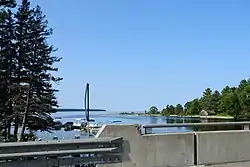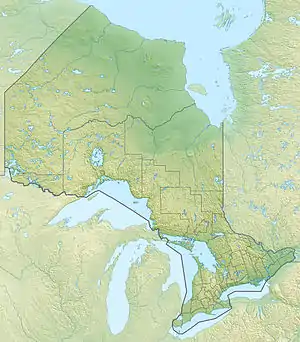Batchawana River
The Batchawana River is a river in Algoma and Sudbury Districts of Ontario, Canada, which empties into Batchawana Bay on Lake Superior north of Sault Ste. Marie, Ontario.[1]
| Batchawana River | |
|---|---|
 Mouth of the Batchawana River at Batchawana Bay | |
 Location of the mouth of the Batchawana River in Ontario | |
| Etymology | From the Ojibwe meaning "swift waters/current" |
| Location | |
| Country | Canada |
| Province | Ontario |
| Region | Northeastern Ontario |
| Districts | |
| Physical characteristics | |
| Source | Unnamed lake |
| • location | Sudbury District |
| • coordinates | 47°14′36″N 83°39′43″W |
| • elevation | 487 m (1,598 ft) |
| Mouth | Batchawana Bay, Lake Superior |
• location | Algoma District |
• coordinates | 46°55′49″N 84°31′42″W |
• elevation | 180 m (590 ft) |
| Length | 95 km (59 mi) |
| Basin features | |
| River system | Great Lakes Basin |
The name "Batchawana" is derived from the Ojibwe word obatchiwanang, meaning "current at the strait" or "narrows and swift water there", and refers to the turbulent or bubbling waters flowing between Batchawana Island and Sand Point (directly east of the Batchawana River's mouth).[2][3]
A trading post was established near the mouth of the river for fur trading around 1817 or 1819 by clerks of the North West Company.[4][5][6] The Hudson's Bay Company appears to have operated a post there as well circa 1868-1869.[7]
Batchawana River Provincial Park encompasses portions of the river, and Batchawana Bay Provincial Park, with a large sandy beach, is located just west of the river's mouth on Batchawana Bay. The Algoma Central Railway crosses the river at the settlement of Batchewana.
North of Batchawana Bay is Pancake Bay, so named because fur traders travelling east from Fort William had only enough flour left to make pancakes.
Tributaries
- Kerwin Creek (left)
- Norberg Creek (left)
- Griffin Creek (left)
- Little Batchawana River (right)
- Mongoose Creek (left)
- St. Clair Creek (left)
- Alder Creek (right)
- Quinn River (left)
- Emerson Creek (left)
- Percy Creek (right)
- Toll Creek (right)
Batchawana River Provincial Park
| Batchawana River Provincial Park | |
|---|---|
| Coordinates | 47°08′02″N 84°24′54″W[8] |
| Area | 2,684 ha (10.36 sq mi)[9] |
| Designation | Waterway |
| Established | 2004 |
| Governing body | Ontario Parks |
The Batchawana River Provincial Park protects certain sections of the river and its banks, as well as some adjacent forests. It was established in 2004 and is meant for canoeing and fishing. Features in the park include wide meanders, numerous rapids, islands, shifting stream channels and a 13 kilometres (8.1 mi) long canyon. The forests include yellow birch, white pine and eastern hemlock, that at the northern end of its range.[9]
It is a non-operating park, meaning that there are no facilities or services.
See also
References
- "Batchawana River". Geographical Names Data Base. Natural Resources Canada.
- Boyle, Terry (2011). Hidden Ontario: secrets from Ontario's past. Toronto: Dundurn Press. p. 106. ISBN 9781554889563.
- Franklin, Dixie (1991). Faces of Lake Superior (1st ed.). [West Bloomfield, MI]: A & M. p. 62. ISBN 9781878005144.
- Ernest Voorhis. "Historic Forts and Trading Posts of the French regime and of the English Fur Trading Companies". www.enhaut.ca. Retrieved 13 September 2021.
- Anick, Norman (1976). "The Fur Trade in Eastern Canada Until 1870" (PDF). Manuscript Report Number. National Historic Parks and Sites Branch, Parks Canada. I (207). Retrieved 13 September 2021.
- Chisholm, Barbara; Gutsche, Andrea; Floren, Russell (1998). Superior: Under the Shadow of the Gods. Toronto: Lynx Images. pp. 28–29. ISBN 978-0-9698427-7-4. OCLC 39380117. Retrieved 13 September 2021.
- Hudson's Bay Company Archives. "HBCA Post Records By Number - Batchewana". www.gov.mb.ca. Province of Manitoba. Retrieved 13 September 2021.
- "Batchawana River Provincial Park". Geographical Names Data Base. Natural Resources Canada.
- "Batchawana River". www.ontarioparks.com. Ontario Parks. Retrieved 10 September 2021.
- "Batchawana River". Geographical Names Data Base. Natural Resources Canada. Retrieved 2010-07-01.
- "Toporama - Topographic Map Shees 41K15, 41K16, 41N1, 41N2, 41N8, 41O4, 41O5". Atlas of Canada. Natural Resources Canada. Archived from the original on 2010-08-31. Retrieved 2010-07-01.